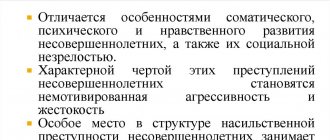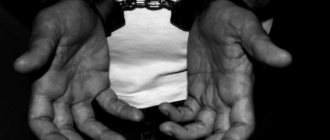According to the norms of Russian legislation, any unfinished criminal act constitutes an attempt. For example, if a person tried to steal someone else's property and was detained, he was attempted theft, and if there was an attempt to kill, he was attempted murder.
Despite the apparent simplicity of the definition of a crime, in practice quite often problems arise with the qualification of such an act. For example, it may be difficult for authorized persons and the victim to determine what exactly the criminal wanted: to simply make a threat and back it up with actions, or to actually kill a person.
The article under the Criminal Code of the Russian Federation for attempted murder provides for many signs that make it possible to accurately determine the intentions that guided the criminal when committing an unlawful act.
Download for viewing and printing:
Criminal Code of the Russian Federation of June 13, 1996 N 63-FZ
What does attempted murder mean?
Committing such an illegal act is possible only with direct intent.
Consequently, when committing such actions, the guilty person wished the death of the victim and tried to achieve a lethal outcome to the crime. Such actions can be qualified as this illegal act only if the actions of the criminal were stopped or suppressed (he failed to fulfill his intentions). That is, for objective reasons, the person’s death never occurred.
Attempted murder of a person can be classified under the following articles:
- Part 3 of Article 30 of the Criminal Code of the Russian Federation.
- Article 105 of the Criminal Code of the Russian Federation.
Download for viewing and printing:
Article 30. Preparation for a crime and attempted crime of the Criminal Code of the Russian Federation
Article 105. Murder of the Criminal Code of the Russian Federation
If during the trial the guilt of the accused is proven, he cannot be subject to punishment exceeding ¾ of the maximum amount of liability provided for in the articles.
Important: Based on the norms of the Criminal Code, attempted murder means the impossibility of the criminal, for objective reasons, to complete his intent.
Characteristics of the assassination attempt
Attempted murder is provided for under Part 3 of Art. 30 of the Criminal Code of Russia. In accordance with the article, an offense is considered to be the actions (inaction) of a criminal committed intentionally and aimed at carrying out the act in the event that the offense was not fully executed due to factors beyond their control.
To better understand this term, you need to describe an example. The former partner stole a large sum of money from N. and disappeared. Because of the theft, N. received emotional trauma (a man betrayed by a woman), which negatively affected his financial situation. Enraged by this incident, N. enters the woman's house with a murder weapon. But N.’s plan is disrupted by a huge dog that attacks him. The victim calls the police, who arrest the unlucky criminal.
This example shows an attempted murder with all the elements of the act: motive, action, weapon, unforeseen factors (dog). Therefore, the violator of the law is charged with attempted murder. The subjective assessment of a criminal act is associated with emotional and intellectual components. And the question arises: why didn’t N. shoot the dog and end the crime?
In practice, lawyers strive to prove that the goals of the offender were not criminal in nature. N. could have entered the woman’s apartment in order to simply talk to her, and not kill her. The man did not shoot the dog, despite the opportunity to do so, which is proof of the peaceful purposes of the visit. But the question remains: why weapons? Answer: you have a permit to carry a weapon (for example, for self-defense). And the woman should be considered a criminal, because she committed the theft. This method can lead to the shifting of responsibility in order to avoid punishment or mitigate it. In this example, the maximum possible incrimination against N. is unauthorized entry into someone else’s home.
Every criminal act consists of 3 phases:
- Preparation;
- assassination attempt;
- act.
The Criminal Code of the Russian Federation considers attempted murder as actions performed by a person to cause the death of the victim with direct intent, but due to factors independent of the offender, not fully executed.
Minors are also punished for attempted murder. The court must accept as true that the juvenile offender did not renounce the attempt on his own, but under the influence of certain reasons.
Attempted murder may be carried out to cover up another crime. Thus, an attempted murder may have the goal of preventing the detection of an organized crime (say, the involvement of government agencies in terrorism). Thus, in the Indian film, someone nicknamed Queen makes an attempt on the life of a chess master in order to prevent the investigation into the minister’s involvement in terrorism. Or, for example, in one series they tried to kill an auditor to cover up theft by writing off a large amount of state flour reserves for personal gain.
A separate article in the Criminal Code of the Russian Federation is devoted to an attempt on the state system, aimed at overthrowing or changing the constitutional system of Russia through violence or violating the integrity of the territorial structure of Russia. A separate article in the Russian Criminal Code defines attempted murder of a public or government figure. This is a special case of attempted murder.
There is an encroachment on a criminal act in a state of passion. But as a rule, preparation for a crime in an affective state does not occur due to the fact that the intent arises and is realized in a short period of time. Usually, an attempt in an affective state is committed with a direct, ambiguous intention with the desire to inflict various injuries on the victim. In these situations, it is necessary to evaluate actions based on the available results in fact, i.e., causing serious harm to health or damage to health of moderate severity.
Often there is an attempted murder for hooligan reasons. In some cases, it is quite difficult to distinguish attempted murder from ordinary hooliganism, and therefore the attacker receives a more lenient sentence. The court may not even sentence the offender to serve a prison sentence, but impose a fine.
An attempt differs from a completed criminal act in that there is no final result in the act. As a rule, it takes place in acts with a material component (murder, robbery).
In the commentary to Article 30, some consultants point to the fact that in acts with formal offenses, an encroachment according to the usual rule never occurs. This point of view is incorrect, since the Criminal Code of Russia includes articles describing acts, the attempted implementation of which is not associated with the execution of long-term actions by the criminal. For example, an attempt to provide a bribe may occur when a possible bribe-taker refuses to accept a reward.
If a formal offense continues for quite a long time, then it may cease, and then the act will take the form of an attempt. For example, desertion by leaving a military unit.
Attempted fraud, which is unlike fraud, is interpreted in the Criminal Code of the Russian Federation not only as certain actions, but also as the absence of actions that could lead to the implementation of the act. Usually this is a failure to comply with job descriptions by employees, although they understood that they were providing the opportunity for fraudsters to carry out the act.
Criminal punishment for attempted fraud is possible only when the fraud is committed on a large or especially large scale.
Types of unfinished murder
Responsibility applies not only in “ordinary” attempts to lead to death, but also in a number of exceptional cases:
- If it was planned to carry out qualified murder with aggravating circumstances.
- If a mother tries to take the life of her newborn child, but for some reason she fails to complete her plan.
- If the death was caused in a state of passion (strong emotional disturbance of a person, which arose suddenly due to the commission of illegal actions by the victim).
Types of assassination attempt
There are several classifications of attempted murder. The first is a completed attempt and an unfinished one. The criterion is the completeness of the criminal’s actions. That is, a person either performs all planned actions, but a negative result does not occur, or not all planned actions are performed. The most important thing is that the crime is interrupted due to circumstances beyond the control of the subject.
The second classification, which is also widely used, is the identification of an unsuitable attempt at a crime as a type, which, in turn, is divided into two independent subspecies: an attempt on an unsuitable object, an object, or an attempt committed with an unsuitable weapon. The criterion in this case is objective signs, both mandatory and optional. Here a clear circumstance appears that did not depend on the subject and prevented the completion of the act, namely the unsuitability of one of the elements of the composition.
When an assassination attempt is impossible
In relation to some illegal acts, there cannot be an attempt. Despite the fact that the death was prevented, the provisions of Article 30 of the Criminal Code do not apply to such crimes.
When self-defense limits are exceeded
Article 108 of the Criminal Code of the Russian Federation provides for holding the guilty person accountable for committing two types of illegal acts that were directed against human life:
- A murder committed by a person exceeding the permissible limits for self-defense.
- A murder that was the result of exceeding the measures the use of which was necessary to apprehend the criminal.
Article 108. Murder committed when exceeding the limits of necessary defense of the Criminal Code of the Russian Federation
The right to defense is a natural right of any person, enshrined at the legislative level. However, if such limits are exceeded, the actions of a citizen countering crime can also be considered an illegal act.
At the level of Russian legislation, a separate norm considers the commission of a murder that occurred when the culprit repelled an attack of a socially dangerous nature.
Such actions will not be considered as exceeding the limits of self-defense, and therefore cannot entail criminal prosecution of the person who committed such actions.
When causing death by negligence
The object of such an illegal act is also human life, however, according to the norms of criminal law, such actions cannot be classified as murder.
Such a death can occur due to the frivolity of the accused, due to his negligence. Such a crime should be distinguished from innocent causing of death, which occurs when the following conditions are met:
- The person did not have the opportunity to foresee the death of the victim, and should have done this according to the circumstances of the case.
- If a person had the opportunity to foresee a likely fatal outcome, but there was no way to prevent it due to the inconsistency of psychophysical qualities with extreme conditions and overloads.
Attention: The conclusion about a person’s guilt in committing such an unlawful act must be based on a thorough analysis of all actions committed by the accused and an objective assessment of the entire situation as a whole.
Types of application of Article 30 to those who killed
The main qualification of what the killers did falls under Article 105 of the Criminal Code. And when such a crime was started but not completed, then this is Article 105 through 30 of the Criminal Code of the Russian Federation. In this case, it makes no difference which part of the 105th is imputed, the first, second or third. At the same time, an additional 30 can also be applied to cases where:
- an attempt by a mother to kill her newborn child was prevented, 106 UKR;
- an attack with the intent to kill, which began under the influence of passion, was stopped, 107 UKR.
In these episodes, direct intent is unambiguous, and only some kind of external intervention, accidental or special, can stop the crime. A mother trying to kill a newborn child is under the onslaught of hormones and is not aware of her actions, just like a potential murderer in a state of passion. Their impulses are aimed precisely at taking the life of the irritant. It’s another matter when death threatens for other reasons.
Problems of distinguishing crimes from other offenses
When studying the Criminal Code of the Russian Federation, it is possible to identify several crimes with a similar composition, which explains the difficulty of qualifying such illegal acts.
- Threat to commit murder. In practice, quite often there are situations when a person, shouting “I’ll kill,” points a knife at another citizen. Such actions are most often committed in the heat of a quarrel, but this does not prevent the problems of distinguishing such a crime from attempted murder. The qualification of the committed criminal act is determined by carefully studying all the circumstances of the case, the details of the incident and reliable information about the direction of the actions committed and the presence of intent. Since there is a huge difference between the penalties for such illegal actions, it is important to qualify them correctly.
- Serious bodily harm. As practice shows, crimes in which grievous bodily harm was caused to the victim are considered the most difficult when assessing the circumstances of the incident. When qualifying an unlawful act, it is necessary to take into account the fact whether the criminal had the intent to kill a person or whether there was a desire only to inflict serious injuries on him so that he would have to restore his health for a long time.
- The ability to complete actions. When delimiting crimes, the ability of the guilty person to complete his actions is also taken into account. For example, if a person strangled another citizen and was stopped by a third person, such actions may be regarded as an attempt. And if no one prevented the criminal from bringing the matter to death, but he stopped on his own, he will be held liable for causing grievous bodily harm.
Subjective signs
From the point of view of subjective signs of a criminal attack provided for in Art. 105 of the Code with the simultaneous application of Art. 30, it is the mental activity of a criminal person, which is in direct connection with the crime he commits. The content of this activity contains a number of legal factors that characterize the criminal activity of a person:
- guilt , which determines the attitude of the criminal to the totality of factors of the objective component of the crime. It must be expressed in the form of an act (or inaction), in relation to the criminal results that have occurred, and is also in a direct connection between the unlawful actions committed and the consequences that occurred after their commission.
- motive , which is determined by certain (emotional, material, etc.) needs of the criminal and guides his actions at the time of criminal acts.
- goal , which is a model of the future final result that the criminal strives to achieve.
It is important not to confuse a state of affect, in which a person experiences strong mental agitation and loss of self-control, with direct intent. This category of crimes is related to the so-called privileged corpus delicti and qualification requires reference to other articles.
To qualify attempted death, there is no separate article of the Criminal Code of the Russian Federation; this crime is always a combination of articles of the current criminal law: Art. 105 via Art. 30 of the Code.
The considered category of criminal attacks implies not bringing the criminal intent to its logical conclusion. Moreover, the circumstances that prevented this were not in the plans of the person who committed the crimes.
Judicial practice for these categories of crimes is such that it does not exceed ¾ of the maximum term implied by Art. 105 of the criminal law of Russia.
How is the sentence term calculated?
The procedure for bringing a person to justice for committing actions characterized as attempted murder is clearly regulated by the relevant Resolution of the Armed Forces of the Russian Federation.
This regulatory act determines that the punishment for the perpetrator is applied in accordance with the standards established by Article 105 of the Criminal Code of the Russian Federation, but the chosen measure must be no more than ¾ of the maximum punishment established in the article. For example, for committing an attempt to kill a person that does not fall within the qualifications (without aggravating circumstances), Article 105 establishes a maximum term of imprisonment of up to 15 years. Accordingly, in the case of attempted murder, a person can be sentenced to a term of just over 11 years.
In what cases are more severe penalties provided?
More severe penalties are established for so-called qualified crimes, that is, murders that were committed with aggravating circumstances. In particular, such murders include:
- Murder of two or more people.
- The murder of a person carrying out official activities, or members of his family, because of his activities, fulfilling his duty to the public.
- The death of a young child or other person who, known to the guilty person, was in a helpless state at the time of the commission of the act.
- The murder of a pregnant woman, which the perpetrator knew about.
- The murder of a person committed with extreme cruelty.
- Death committed in a manner that poses a public danger.
- Actions and murders committed based on blood feud.
- A crime that was committed by a group of persons, including those situations where such citizens acted by prior conspiracy.
- Actions committed for hire or for selfish purposes.
- Acts committed to conceal other crimes or facilitate their commission.
- Murder motivated by racial, political or national hatred.
- Crimes committed for the purpose of further use of the victim’s organs or tissues.
Article 105 of the Criminal Code of the Russian Federation provides for liability for such illegal acts in the form of imprisonment for up to 20 years or life imprisonment. However, since a person cannot be sentenced for life for attempted murder, when calculating the sentence, the judge takes into account exactly the 20-year time period. Therefore, the maximum sentence for qualified attempt is 15 years.
Types and examples
The question of what this crime consists of should be analyzed using examples from real judicial practice.
Example 1. Citizen Ivanov, in order to individually receive an inheritance from his father, decided to “remove” his competitors, his older brother and sister, with whom he had strained relations, from his road. Choosing a pistol as his “punitive weapon,” Ivanov fired two shots (not in a crowded place) at his relatives. As a result, the older brother was seriously wounded in the chest, and the sister was wounded in the shoulder. Due to the timely call of an ambulance and thanks to the competent work of doctors, the brother and sister remained alive.
In this example, there are two aggravating circumstances characteristic of paragraphs “a” and “h” of Part 2 of Art. 105 of the Criminal Code of the Russian Federation.
Example 2. Citizen Sidorov spent a long time planning exactly how he would take the life of his wife’s lover. As a result, he kidnaps him and locks him in the basement of his own house, where he subjects him to all sorts of torture and beatings. As a result, Sidorov decides to kill and begins to strangle his captive, but at that moment a local police officer was passing by the house and, hearing a plea for help, burst into the basement in time and stopped Sidorov’s actions, which were undoubtedly aimed at causing death.
Sidorov’s actions are typical for paragraph “e” of Part 2 of Art. 105 of the Criminal Code of the Russian Federation.
Example 3. Citizen Alekseev, trying to hide the fact that he had committed another illegal act - rape, decided on an even more terrible act and intended to kill his victim so that she would not be able to contact the police and, accordingly, he could feel relatively safe. The incident took place in a public park, off the footpath, near a pond. At that moment, when Alekseev began to drown the victim, two young men passed by and, using force, detained the criminal.
It is also necessary to understand that this act can be considered not only within the framework of Article 105 of the Criminal Code of the Russian Federation.
Article 106 of the Criminal Code of the Russian Federation - the murder of a newborn child by a mother is a terrible act both by law and by moral and human standards, but, unfortunately, quite often encountered.
For example, citizen Ivannikova did her best to hide her pregnancy from her relatives. This citizen was in her last month of pregnancy in her apartment; she went into labor, and since she did not like pregnancy, she did not call an ambulance. Miraculously, the birth was successful, but, realizing that it is now no longer possible to hide her situation, the new mother decides to do a terrible thing. Using a pillow, she begins to strangle the newborn child, but fortunately, a neighbor arrived in time to the screams, interrupted the criminal’s actions and thereby saved the child’s life.
So, the provisions of Article 106 of the Criminal Code of the Russian Federation are as follows:
Causing death by a mother of a newborn child during or immediately after childbirth, as well as murder by a mother of a newborn child in a psychotraumatic situation or in a state of mental disorder that does not preclude sanity, is punishable by restriction of freedom for a term of two to four years, or by forced labor for a term of up to five. years, or imprisonment for the same period.
Article 107 of the Criminal Code of the Russian Federation is murder committed in a state of passion. Example:
The young man, Full Name 1, was subjected to insults and humiliation in every possible way from his fellow students. The situation went far, and Full Name 1 even had to turn to psychologists, but this did not stop the villains. Walking home after classes, Full Name 1 sees how, in the entrance of his house, one of his fellow students is writing all sorts of insults about him, including those concerning his parents.
Because of this, FULL NAME 1 begins an attack of uncontrollable aggression, he runs up to the “artist”, delivers a series of punches to the head area and begins to choke him. At the last moment, when the victim was already in a dying state, mother FULL NAME 1 ran out to the noise and managed to pull her son away in time and call an ambulance. The victim was taken to the hospital, where he was miraculously saved.
In this example, due to the established circumstances of all kinds of insults and the psychological state of Full Name 1, it would be incorrect to classify the crime committed as intentional; the qualification should be in accordance with the provisions of Article 107 of the Criminal Code of the Russian Federation, which states the following:
- Murder committed in a state of sudden strong emotional disturbance (affect) caused by violence, mockery or grave insult on the part of the victim or other illegal or immoral actions (inaction) of the victim, as well as a long-term psychologically traumatic situation that arose in connection with systematic illegal or immoral behavior victim, is punished by correctional labor for up to two years, restriction of freedom for up to three years, or forced labor for up to three years, or imprisonment for the same term.
- The murder of two or more persons committed in a state of passion is punishable by forced labor for up to five years or imprisonment for the same period.
Selected legal aspects of the crime
Jurisdiction, characteristics of the crime, arguments
Cases of attempted murder are heard by city or district courts.
Bringing the guilty person to justice occurs in accordance with the standards established in Article 105 of the Criminal Code of the Russian Federation. At the same time, the application of liability measures within the framework of Part 3 of Article 30 of this normative act is possible only in cases where, as a result of the commission of criminal actions, death did not occur.
The amount of punishment applied directly depends on the qualifications of the unlawful act.
Statute of limitations for bringing the perpetrator to criminal liability
The statute of limitations under which a guilty person can be held accountable for committing an unlawful act directly depends on the nature of the crime: the general statute of limitations is 15 years.
What legal provisions apply?
As practice shows, the determination of the rules of law according to which the case is considered and responsibility arises depends directly on the nature of the act. In relation to murder, the punishment for the culprit will be based on the provisions of Art. 105 of the Criminal Code of the Russian Federation. The first part of this standard indicates the commission of certain acts, the purpose of which was murder. However, in this situation there are no circumstances designated as aggravating.
If certain reasons are identified that are classified as aggravating, the case will be considered on the basis of the principles set out in the second part of the standard. But even here there are some peculiarities. So, if there is a situation in which the attempt was made with a hooligan motive, then the criminal will be charged with two standards of criminal law at once - part 3 of article 30 of the Criminal Code and part 2 of article 105 of the Criminal Code of the Russian Federation.
In some situations, you may encounter acts that were not completed, but for one reason or another do not fall under the established norms of domestic criminal law. In this case, the punishment will be according to the standard that is incremented to the culprit (106 or 107) indicating the provisions of the criminal law.
Distinctions with other crimes
In some cases, when assigning qualifications to such atrocities, difficulties may arise that mislead legal experts. For example, the guilty person states that he had no intention of actually killing a person, he simply threatened him. How to determine truth?
How to distinguish a “simple threat”
There is no clear formula; each such incident will have to be carefully studied and subjected to legal, psychological, medical and other analysis. The difference between the term for attempted murder and threat (p. 119 of the Criminal Code of the Russian Federation) does not give any room for error. After all, the first offense is punishable by imprisonment for up to 11 years, and the second – up to 2 years.
Legislation for any episodes of attacks on life and health involves the following algorithms for establishing the truth:
- Determine the legal signs of intent to commit a crime - for a specific purpose, through negligence.
- Formulate the motive for the action from a legislative point of view.
- Collect and record in detail all the circumstances surrounding the crime.
- Compare all the information obtained by completing the first 3 points, and draw logical conclusions about the intent with which it was possible to perform the action in question.
In an example it will look like this. In the workshop, a skirmish arose between factory worker Serov M. and his partner Voronov V., during which Serov leaned on his opponent with his whole body, knocked him to the floor and grabbed him by the throat. Serov began to strangle Voronov, and did this until the foreman ran in and pulled the strangler away from the victim. Voronov had to be taken to the hospital. Serov justified himself by saying that he simply wanted to scare and suppress his opponent, but not kill him.
A criminal trial was initiated, then a trial took place. The judge found Serov guilty under Article 105, Part 1, together with Article 30, Part 3, and sentenced him to 11 years in prison. The court did not accept the defendant's arguments that it was just a threat. How was such a decision formed, according to the algorithm described above:
- Was there a plan for the action - yes, the accused attacked the victim deliberately, with the specific purpose of causing harm.
- As a result of strangulation, Voronov received a serious injury to the trachea, which led to long-term treatment and disability. According to the doctors' opinions, if the strangulation had not been stopped, the death of the victim would have occurred. Accordingly, the motive for the crime from a legal point of view is an attack on life.
- The accused Serov M. is 190 cm tall and weighs 114 kg, and has been professionally engaged in freestyle wrestling for a long time. The victim, Voronov V., was 170 cm tall, weighed 65 kg, and did not engage in sports.
- Based on the collected data, a conclusion is formulated: without the intervention of an outsider, Serov would have killed Voronov, albeit in a fit of resentment. Being a professional athlete, Serov could not help but evaluate the opponent’s chances, but he used force against him that was disproportionate to a simple threat. Hence the charge and sentence for attempted murder, according to the Criminal Code of the Russian Federation.
Thus, when distinguishing motives, it is important to take into account the totality of absolutely all the circumstances of the case, both objective and subjective.
Grievous bodily harm
Another difficult definition for legal practice in Russia is the qualification of grievous bodily harm, p. 111 of the Criminal Code. It is often difficult to determine what exactly in the face of law is unfinished murder or serious, dangerous damage to health, but without the desire to destroy. Detailed collection and study of all aspects of the incident also helps to differentiate between these concepts.
The first step is to find out how prepared the culprit was for such a turn of events. Thus, a person who gets involved in a spontaneous fight does not necessarily intend to bring the enemy to death; here there is usually simple cruelty leading to serious physical harm. In addition, in the heat of “battle” it is not always possible to determine whether a person will die from a particular blow or not. At the same time, the danger of blows must be proven by expert opinions - whether something like this can always lead to death if you do not intervene in time, or whether a fatal coincidence of circumstances occurred, etc.
However, if in the same fight someone pulled out a sharp, piercing, heavy object and deliberately struck the victim's vital organs, it is difficult to believe that the striker did not understand the consequences of his behavior. And an attacker should not count on a “lighter” p.111 UCR.
In order to understand as fully as possible exactly when section 30 works, it will be useful to study the detailed comments on the latter, updated literally in 2020-2021.







